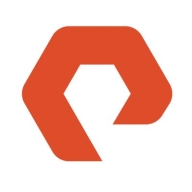


The Hitachi Virtual Storage Platform and Pure Storage FlashArray are leading storage solutions in the market. Pure Storage FlashArray generally receives higher satisfaction for its advanced features and ease of use, while Hitachi Virtual Storage Platform is favored for its robustness and reliability in complex environments.
Features: Hitachi Virtual Storage Platform offers robust data management, high availability, and reliability in complex environments. Pure Storage FlashArray excels in speed, deduplication, and data compression. Users find Pure Storage's features more innovative and user-friendly.
Room for Improvement: Hitachi users often call for improved scalability, better integration tools, and more advanced automation. Pure Storage users suggest increased capacity options, enhanced data protection features, and more flexible pricing models.
Ease of Deployment and Customer Service: Hitachi Virtual Storage Platform is noted for its comprehensive deployment process, which can be complex and time-consuming, and its strong customer support. Pure Storage FlashArray is praised for its straightforward deployment and responsive customer service. Pure Storage has an advantage due to its simplicity and effective support.
Pricing and ROI: Hitachi Virtual Storage Platform tends to have higher initial setup costs but delivers strong long-term ROI due to its durability. Pure Storage FlashArray, while perceived as costlier upfront, justifies its price with measurable performance gains and operational efficiency. Both products offer solid ROI, but Pure Storage's immediate performance benefits make it more appealing to users.



Pure Storage FlashArray//X is the world’s first enterprise-class, all-NVMe flash storage array. It represents a new class of storage – shared accelerated storage, which is a term coined by Gartner – that delivers major breakthroughs in performance, simplicity, and consolidation.
RETHINK YOUR DEFINITION OF SPEED AND PERFORMANCE
With adaptive, guaranteed data reduction and a 100% data-availability guarantee, Hitachi Virtual Storage Platform F series helps you tackle complicated business challenges. Hitachi Data Systems (HDS) VSP F series delivers up to 4.8M IOPS with sub-millisecond response times.
Featuring legendary Hitachi reliability, VSP F series arrays are backed by the industries only 100% availability guarantee. For these reasons, 80% of the Fortune 500 choose Hitachi all-flash arrays to accelerate the performance of mission-critical applications like Oracle, SAP, Virtualization, Microsoft apps etc. With over 350 patents in flash technology, Hitachi’s innovative mix of flash hardware and software accelerates ROI with enterprise-class reliability and performance.
Pure Storage FlashArray is the world’s first enterprise-class storage array that runs exclusively on the nonvolatile memory express (NVMe) protocol for memory access and storage. It represents a totally state-of-the-art type of storage technology. It offers users shared accelerated storage that delivers cutting-edge features in the realms of performance, simplicity, and consolidation. Pure Storage is fresh and modern today and will be for the next decade. Without forklift upgrades or planned downtime, Pure Storage takes the work out of storage ownership and delivers unprecedented customer satisfaction.
Pure Storage FlashArray is built with simplicity and reliability in mind. The solution can be implemented and optimized in hours, as opposed to other similar solutions that can take days. It has no moving parts, which removes areas where it could potentially be vulnerable to suffering errors. It is highly stable and gives users the ability to manage system shutdowns in a way that prevents data loss.
Benefits of Pure Storage FlashArray
Some of the benefits of using Pure Storage FlashArray include:
Reviews from Real Users
Pure Storage FlashArray is a highly effective piece of storage technology which stands out among its competitors for a number of reasons. Two major ones are its overall robustness and the value that it offers by way of its reliability and ease of use. It provides users with many valuable features that allow them to maximize what they can do with this solution. Pure Storage FlashArray’s reliability and ease of use make it a highly valuable solution.
PeerSpot user Prabakaran K., a technical consultant at Injazat Data Systems, notes the robustness of this solution when he writes, "FlashArray has many valuable features. It's very user-friendly and it has high availability, so there is comparatively less downtime. During maintenance, there is no shutdown procedure, so you can directly power off the Array and manage the shutdown process without any data loss, which is a unique feature. Managing replication and data migration is also very easy."
PeerSpot user Jason D., a cloud solutions architect at a tech services company, notes three features that make this solution valuable when he writes, "We've had different types of storage, and three things of this solution are valuable. The first one is its outstanding performance. The second one is its stability. In the about three years that we've had it, we've had component failures, but we never had a service interruption or any data loss. The third one, which is really critical, is that it is super easy to use in terms of provisioning, storage, and managing the arrays. I'm able to maintain a multi-site environment with a couple of dozen arrays with a single mid-level storage admin."
We monitor all All-Flash Storage reviews to prevent fraudulent reviews and keep review quality high. We do not post reviews by company employees or direct competitors. We validate each review for authenticity via cross-reference with LinkedIn, and personal follow-up with the reviewer when necessary.